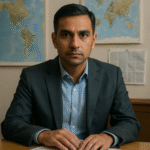New Delhi, August 13: There wasn’t much fanfare, no big headlines screaming across channels. But today in Delhi, something important happened and it had less to do with speeches, more with sitting down and getting real. Senior ministers from India and Singapore came together for the third India–Singapore Ministerial Roundtable (ISMR). It wasn’t about optics this time. It was about course correction, clarity, and figuring out what next.

Heavy Names Around the Table
Let’s just start with the sheer weight in the room. On India’s end: Nirmala Sitharaman, S. Jaishankar, Piyush Goyal, Ashwini Vaishnaw every one of them running portfolios that touch the economy in one way or another. Singapore sent in an equally tough lineup: Deputy Prime Minister Gan Kim Yong, K. Shanmugam, Vivian Balakrishnan, Josephine Teo, and others. This wasn’t a symbolic handshake. When you send this many Cabinet ministers, you’re not just keeping up appearances you’re trying to get something done.
And that tone? It came through. According to people familiar with the mood in the room, the conversations were brisk, sometimes blunt. Which is probably exactly what the relationship needs right now.
Talking Points with Teeth
The dialogue covered six sectors not new ones, but areas that’ve been on the radar for a while now: manufacturing, digital infrastructure, connectivity, healthcare, skill-building, and sustainability. Normally, these topics come and go in press releases. But this time, ministers actually sat with data. They went into what’s working, what’s not, and where bureaucracies have jammed up progress.
One insider said the India–Singapore Business Roundtable Report, which was shared during the meet, wasn’t just passed around politely it was interrogated. The private sector’s feedback carried weight. It should. Business, not bureaucracy, often ends up being the difference between joint declarations and actual results.
A Quiet Visit to the President
At some point in the day, the Singaporean delegation stopped by Rashtrapati Bhavan to meet President Droupadi Murmu. There was no big media glare on it. But in diplomatic circles, gestures like this don’t go unnoticed. It’s less about protocol and more about reaffirming the depth of the relationship symbolic, yes, but also strategic.
Mumbai’s Cameo and Why It Matters
Here’s something interesting: Singapore specifically flagged Mumbai in its remarks. Not Delhi. Not Bengaluru. Mumbai. That matters.
Because when a foreign delegation points to Mumbai as a centre for economic engagement, they’re not just talking trade. They’re talking about access points financial systems, port infrastructure, digital hubs. And they’re placing bets on where the real capital flows are headed.
It’s also a reminder that diplomacy today doesn’t stop at the national level. Cities like Mumbai are becoming standalone diplomatic players in some sense especially in economic dialogues.
More Than a Trade Chat The Strategic Layer
Now, peel back the formal structure of the roundtable and you’ll see what’s really going on. This isn’t just a business relationship. It’s political. It’s regional. And it’s a bit urgent.
India’s Act East Policy has been around for a while, but let’s be honest it’s often struggled for traction. Singapore, meanwhile, is dealing with its own balancing act as Southeast Asia grows more contested. When both countries meet like this, with this level of seriousness, it’s usually about more than what’s on paper.
You get the feeling they’re trying to recalibrate. Not just in economic terms, but in how they show up in the Indo-Pacific. Neither country is looking to provoke, but both want options. This roundtable if you read between the lines is about building some of those options together.
Not a One-Off
This isn’t a one-time conversation either. The ISMR format started in September 2022, then again in August 2024, and now this the third year in a row. That kind of frequency doesn’t happen unless both sides see value.
What’s more, it’s gaining traction at the right level. These aren’t bureaucrats cycling through talking points. These are Cabinet ministers who actually make decisions. So even if the public statements feel measured, the subtext is that India and Singapore are slowly, carefully, pushing their relationship into a deeper, more operational phase.
Still, Ground Realities Apply
Of course, just because a roundtable was productive doesn’t mean the job’s done. Implementation as always is the real mountain. Cross-border projects are hard. Timelines slip. And somewhere, someone always forgets to follow up.
But that’s the game, isn’t it? Governments lay the foundation. The rest the real work happens afterwards.
Still, you walk away from this year’s ISMR with a sense that something is shifting. Less talk. More doing. And a growing awareness that this partnership, if nurtured right, could shape more than just trade flows it could influence how this region responds to a world that’s getting faster, more complex, and harder to predict.
That doesn’t happen with one meeting. But it has to start somewhere. And today, in New Delhi, it did.
Stay ahead with Hindustan Herald — bringing you trusted news, sharp analysis, and stories that matter across Politics, Business, Technology, Sports, Entertainment, Lifestyle, and more.
Connect with us on Facebook, Instagram, X (Twitter), LinkedIn, YouTube, and join our Telegram community @hindustanherald for real-time updates.
Specializes in South Asian geopolitics and global diplomacy, bringing in-depth analysis on international relations.






